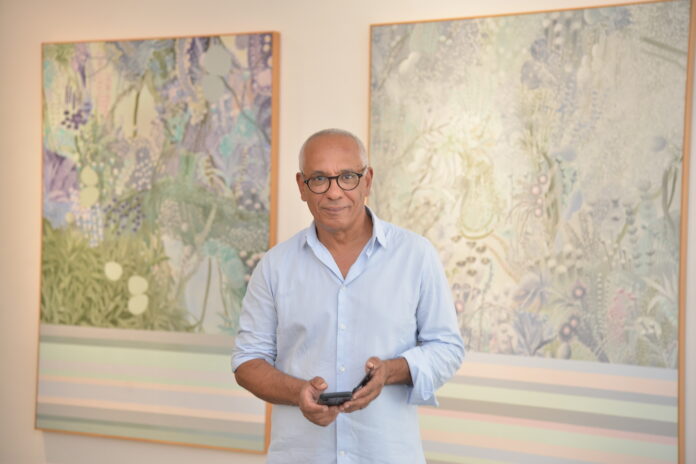LONDON: The paintings of Moroccan artist Abderrahim Yamou give a fresh and sometimes startling perspective on the wonders of the natural world. Yamou, it seems, notices details which most miss — so, a seed is portrayed in all its splendor and given the same prominence as a tree trunk or a flower. It’s like walking into a new dimension, where normal proportions and perspectives no longer apply.
Yamou says his science background shaped his acute observation of nature. As an undergraduate, he studied biology at the University of Toulouse, before earning the French equivalent of a Master’s degree in the history of contemporary art in Morocco at the Sorbonne. It wasn’t until 1986, however, aged 27, that he decided to commit himself fully to art.
Yamou, “Les terrasses,” 146 x 114. (Supplied)
Yamou’s imagination is also fired by his homeland of Morocco. Born in Casablanca in 1959, he showed a leaning towards art from an early age, drawing on any surface he could find. This artistic drive didn’t come from his father — a blind lottery vendor — or his mother (“I was born in a humble, respectful and caring environment,” he tells Arab News), but he was given the space to be creative, as reflected in the wide range of mediums he uses. Apart from his paintings, Yamou also creates sculptures inspired by traditional African art, most notably N’Konde statuettes from Bas Congo.
He describes how, early on, he started “working with earth.”
“I mixed the earth with glue and spread it out on a wooden surface. When I kneaded this material, I had a wish to see a green shoot. But that was impossible because the glue sterilized the soil,” he says. “My interest in plants, gardens and trees stems from this time and also has its roots in the south of Morocco, where green symbolizes life and survival.’
Yamou, “Dunes Vertes,” 146 x 1 14. (Supplied)
That interest has been maintained throughout his life. It’s particularly clear in his series “Branches” and “Chlorophyll” series.
Of the former, he says: “I was interested in the movement and direction that a branch takes to go towards light. On this journey, the plant undergoes constraints which force the branches to contort in order to move forward. I have observed these contortions a lot in my garden and I find them aesthetically beautiful — a poetry of effort and dancing resistance.”
Discussing “Molecule P1,” a painting from the “Chlorophyll” series, he explains: “I am interested in the interior of plants — the molecules that constitute them and the atoms of chlorophyll. In this painting, branches, seeds, flowers and atoms coexist. My view of nature is much more poetic than botanical.”
Yamou, “Les dansantes,” 114×146. (Supplied)
Yamou currently divides his time between Paris and Tahannaout, a village south of Marrakesh, near the foot of the Atlas Mountains. But the place he most loves to be, he says, is his studio.
“Except for external constraints, I like to be in the workshop every day. It’s a place of research and chosen solitude. I keep the rigor and constancy of my former scientific studies,” he explains.
His close observation of nature over many years has led Yamou to form some carefully considered opinions about how best to look after our planet.
Yamou, “Novembre,” 100 x 100. (Supplied)
“We are all aware of the growing environmental concerns. But to reverse this, we need more than awareness,” he says. “We need to invent another way of living; we need to make more room for the other inhabitants of the earth — all the other living things, the flora and fauna. We need to realize that plants and animals are also inhabitants of this planet and that their presence contributes to the global balance. We must gradually reduce the number of humans on earth and learn to live with less — except for those who have nothing or very little.”
He encourages people to persevere with their personal efforts to protect the planet, as each and every action is worthwhile and builds a momentum for change.
“While waiting for collective action to take effect, it is not useless to proceed individually to reduce all that appears harmful to us,” he concludes.

